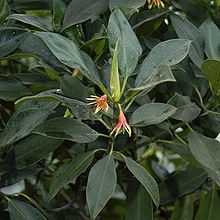Bruguiera gymnorrhiza
| Bruguiera gymnorrhiza | |
|---|---|
 | |
| Scientific classification | |
| Kingdom: | Plantae |
| (unranked): | Angiosperms |
| (unranked): | Eudicots |
| (unranked): | Rosids |
| Order: | Malpighiales |
| Family: | Rhizophoraceae |
| Genus: | Bruguiera |
| Species: | B. gymnorrhiza |
| Binomial name | |
| Bruguiera gymnorrhiza (L.) Lam. | |
Bruguiera gymnorrhiza (black mangrove, Afrikaans: Swart-wortelboom, Xhosa: Isikhangati, Zulu: Isihlobane)[1] is a small tree up to 10 m high that belongs to the family Rhizophoraceae. It is found on the seaward side of mangrove swamps, often in the company of Rhizophora. Its bark is rough and reddish-brown. The tree develops short prop-roots rather than long stilt-roots. Flowers are creamy-white soon turning brown. The sepals are persistent, narrow and slightly tapered. When mature, the spindle-shaped fruits drop and become embedded in the mud in an upright position, where they rapidly develop roots.
The black mangrove is a protected tree in South Africa.[1]
Uses
In the Maldives this mangrove is known as kaṇḍū. The propagules or green pods are eaten as a cooked vegetable. They are peeled first and then boiled, the water being discarded and renewed at least four times. The propagules of this species are more appreciated than those of Bruguiera cylindrica.[2]
See also
- List of Southern African indigenous trees
Notes
- ↑ 1.0 1.1 "Protected Trees". Department of Water Affairs and Forestry, Republic of South Africa. 3 May 2013.
- ↑ Xavier Romero-Frias, The Maldive Islanders, A Study of the Popular Culture of an Ancient Ocean Kingdom, Barcelona 1999, ISBN 84-7254-801-5
References
- "Bruguiera gymnorrhiza". Plantz Afrika. Retrieved 2010-02-08.
- Van Wyk, B. and van Wyk, P. 1997. Field Guide to trees of South Africa. Struik, Cape Town